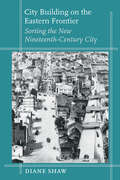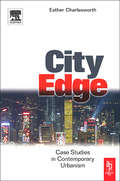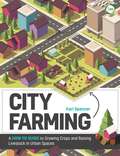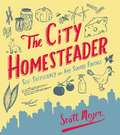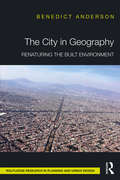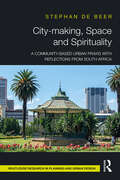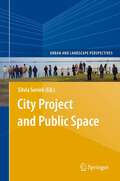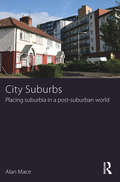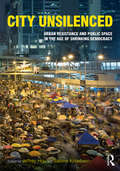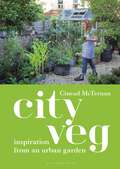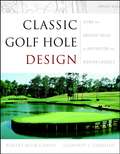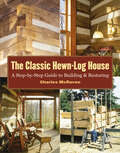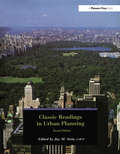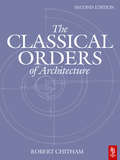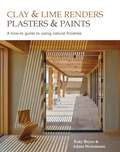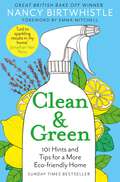- Table View
- List View
City Building on the Eastern Frontier: Sorting the New Nineteenth-Century City (Creating the North American Landscape)
by Diane ShawAmerica's westward expansion involved more than pushing the frontier across the Mississippi toward the Pacific; it also consisted of urbanizing undeveloped regions of the colonial states. In 1810, New York's future governor DeWitt Clinton marveled that the "rage for erecting villages is a perfect mania." The development of Rochester and Syracuse illuminates the national experience of internal economic and cultural colonization during the first half of the nineteenth century. Architectural historian Diane Shaw examines the ways in which these new cities were shaped by a variety of constituents—founders, merchants, politicians, and settlers—as opportunities to extend the commercial and social benefits of the market economy and a merchant culture to America's interior. At the same time, she analyzes how these priorities resulted in a new approach to urban planning.According to Shaw, city founders and residents deliberately arranged urban space into three segmented districts—commercial, industrial, and civic—to promote a self-fulfilling vision of a profitable and urbane city. Shaw uncovers a distinctly new model of urbanization that challenges previous paradigms of the physical and social construction of nineteenth-century cities. Within two generations, the new cities of Rochester and Syracuse were sorted at multiple scales, including not only the functional definition of districts, but also the refinement of building types and styles, the stratification of building interiors by floor, and even the coding of public space by class, gender, and race. Shaw's groundbreaking model of early nineteenth-century urban design and spatial culture is a major contribution to the interdisciplinary study of the American city.
City Edge
by Esther CharlesworthThis series of essays outlines a number of case studies from Europe, North America, Australia and Asia and provides first hand accounts of the experiences that planners, architects and politicians have had in reshaping cities. These insights provide a pragmatic assessment of the challenges and constraints posed by changing patterns of urban growth in a broad spectrum of urban environments. The reader will discover, through these multiple voices and views, the diverse forms of global cities, and will have a grasp of where the debate on urban design stands today, and where it may be going in the future.
City Edge
by Esther CharlesworthThis series of essays outlines a number of case studies from Europe, North America, Australia and Asia and provides first hand accounts of the experiences that planners, architects and politicians have had in reshaping cities. These insights provide a pragmatic assessment of the challenges and constraints posed by changing patterns of urban growth in a broad spectrum of urban environments. The reader will discover, through these multiple voices and views, the diverse forms of global cities, and will have a grasp of where the debate on urban design stands today, and where it may be going in the future.
City Farming: A How-to Guide To Growing Crops And Raising Livestock In Urban Spaces (PDF)
by Kari SpencerFarming in cities and small spaces is becoming increasingly popular, but it has its challenges. City Farming addresses the problems the urban farmer might face and turns them into creative solutions. It assists the new grower to gain expert understanding of how to create a production urban farm, as well as helping established farmers to troubleshoot and discover new ways to bring their space into greater harmony and production. From the perspective of a holistic gardener, growing plants and raising livestock are covered as well as integrated approaches, which bring together the whole farming system in a small space to produce high yields with minimal energy and effort.The content is organised by themes of importance to urban farmers - sun and heat, water usage, seasonal production, spatial planning, soil quality and usage, propagation and breeding, pests and diseases, farming under time constraints, sustainability and community initiatives. These are all discussed within the context of urban farming and include common issues and strategies like microclimates in built-up areas, natural and organic approaches, water harvesting, toxic land, roof gardening, converting ornamental gardens to productive edible gardens, municipal regulations, vertical gardening, aquaponics, composting methods, livestock suitability in limited space, Community Supported Agriculture (CSA) schemes, permaculture in small spaces, community gardens and trade & barter schemes.Each chapter unfolds a piece the story of The Micro Farm Project that provides an overview of the theme, and then discusses the crop and livestock considerations relating to the theme of the chapter in the form of the challenges they present and practical solutions to the problems such as lack of space, high population density, poor soil quality, planning restrictions etc. Case studies giving examples of different methods used within urban farming from different regions throughout the world are included.City Farming is a beautifully illustrated source that can be valuable to both beginners and more experienced urban farmers.
City Farming: A How-to Guide To Growing Crops And Raising Livestock In Urban Spaces
by Kari SpencerFarming in cities and small spaces is becoming increasingly popular, but it has its challenges. City Farming addresses the problems the urban farmer might face and turns them into creative solutions. It assists the new grower to gain expert understanding of how to create a production urban farm, as well as helping established farmers to troubleshoot and discover new ways to bring their space into greater harmony and production. From the perspective of a holistic gardener, growing plants and raising livestock are covered as well as integrated approaches, which bring together the whole farming system in a small space to produce high yields with minimal energy and effort.The content is organised by themes of importance to urban farmers - sun and heat, water usage, seasonal production, spatial planning, soil quality and usage, propagation and breeding, pests and diseases, farming under time constraints, sustainability and community initiatives. These are all discussed within the context of urban farming and include common issues and strategies like microclimates in built-up areas, natural and organic approaches, water harvesting, toxic land, roof gardening, converting ornamental gardens to productive edible gardens, municipal regulations, vertical gardening, aquaponics, composting methods, livestock suitability in limited space, Community Supported Agriculture (CSA) schemes, permaculture in small spaces, community gardens and trade & barter schemes.Each chapter unfolds a piece the story of The Micro Farm Project that provides an overview of the theme, and then discusses the crop and livestock considerations relating to the theme of the chapter in the form of the challenges they present and practical solutions to the problems such as lack of space, high population density, poor soil quality, planning restrictions etc. Case studies giving examples of different methods used within urban farming from different regions throughout the world are included.City Farming is a beautifully illustrated source that can be valuable to both beginners and more experienced urban farmers.
The City Homesteader: Self-Sufficiency on Any Square Footage
by Scott MeyerThe City Homesteader is the handbook for the world of self-sufficient living. It's about living tangibly in a virtual world. It's about being resourceful, saving money, reducing consumption, and increasing self-reliance. Join the many who are raising backyard chickens in the city and tilling their side yards: tapping into natural energy, managing homes more efficiently, and getting back to the earth. Explore the homesteading arts: gardening on small and large scales, raising dwarf fruit trees, sprouting grains, smoking meats and fish, grinding grains for flour, making cheese, making wine, cellaring, heating without fossil fuel, harvesting rainwater, composting, and much moreThe City Homesteader provides all the basics, including how to find supplies and step-by-step instructions that make it easy to follow along. Original illustrations throughout help you create your very own homestead on any piece of earth.
The City in Geography: Renaturing the Built Environment
by Benedict AndersonMonumental in scale and epic in development, cities have become the most visible and significant symbol of human progress. The geography on and around which they are constructed, however, has come to be viewed merely in terms of its resources and is often laid to waste once its assets have been stripped. The City in Geography is an urban exploration through this phenomenon, from settlement to city through physical geography, which reveals an incremental progression of removing terrain, topography and geography from the built environment, ushering in and advancing global destruction and instability. This book explains how the fall of geography in relationship to human survival has come through the loss of contact between urban dwellers and physical terrain, and details the radical rethinking required to remedy the separations between the city, its inhabitants and the landscape upon which it was built.
The City in Geography: Renaturing the Built Environment
by Benedict AndersonMonumental in scale and epic in development, cities have become the most visible and significant symbol of human progress. The geography on and around which they are constructed, however, has come to be viewed merely in terms of its resources and is often laid to waste once its assets have been stripped. The City in Geography is an urban exploration through this phenomenon, from settlement to city through physical geography, which reveals an incremental progression of removing terrain, topography and geography from the built environment, ushering in and advancing global destruction and instability. This book explains how the fall of geography in relationship to human survival has come through the loss of contact between urban dwellers and physical terrain, and details the radical rethinking required to remedy the separations between the city, its inhabitants and the landscape upon which it was built.
City-making, Space and Spirituality: A Community-Based Urban Praxis with Reflections from South Africa
by Stéphan de BeerThis book is about the soul of the city, embodied in its spaces and people. It traces dynamics in inner city neighbourhoods of South Africa’s post-apartheid capital, Pretoria. Viewing the city through its most vulnerable people and places, it recognizes that urban space is never neutral and shaped by competing value frameworks. The first part of the book invites planners, city-makers, and ordinary urban citizens, to consider a new self-understanding, reclaiming their agency in the city-making process. Through the metaphor of "becoming like children", planning practice is deconstructed and re-imagined. A praxis-based methodology is presented, cultivating four distinct moments of entering, reading, imagining and co-constructing the city. After deconstructing urban spaces and discourses, the second part of the book explores a concrete spirituality and ethic of urban space. It argues for a shift from planning as technocracy, to planning as immersed, participatory artistry: opening up to the "genius" of space, responsive to urban cries, and joining to construct new, soul-full spaces. Local communities and interconnected movements become embodiments of urban alternatives – through resistance and reconstruction; building on local assets; animating local reclamations; and weaving nets of hope that will span the entire city. Providing a concrete methodology for city-making that is rooted in a community-based urban praxis, this book will be of interest to urban planning researchers, professional planners and designers and also grass-root community developers or activists.
City-making, Space and Spirituality: A Community-Based Urban Praxis with Reflections from South Africa
by Stéphan de BeerThis book is about the soul of the city, embodied in its spaces and people. It traces dynamics in inner city neighbourhoods of South Africa’s post-apartheid capital, Pretoria. Viewing the city through its most vulnerable people and places, it recognizes that urban space is never neutral and shaped by competing value frameworks. The first part of the book invites planners, city-makers, and ordinary urban citizens, to consider a new self-understanding, reclaiming their agency in the city-making process. Through the metaphor of "becoming like children", planning practice is deconstructed and re-imagined. A praxis-based methodology is presented, cultivating four distinct moments of entering, reading, imagining and co-constructing the city. After deconstructing urban spaces and discourses, the second part of the book explores a concrete spirituality and ethic of urban space. It argues for a shift from planning as technocracy, to planning as immersed, participatory artistry: opening up to the "genius" of space, responsive to urban cries, and joining to construct new, soul-full spaces. Local communities and interconnected movements become embodiments of urban alternatives – through resistance and reconstruction; building on local assets; animating local reclamations; and weaving nets of hope that will span the entire city. Providing a concrete methodology for city-making that is rooted in a community-based urban praxis, this book will be of interest to urban planning researchers, professional planners and designers and also grass-root community developers or activists.
City Project and Public Space (Urban and Landscape Perspectives #14)
by Silvia SerreliThe book aims at nurturing theoretic reflection on the city and the territory and working out and applying methods and techniques for improving our physical and social landscapes. The main issue is developed around the projectual dimension, with the objective of visualising both the city and the territory from a particular viewpoint, which singles out the territorial dimension as the city’s space of communication and negotiation. Issues that characterise the dynamics of city development will be faced, such as the new, fresh relations between urban societies and physical space, the right to the city, urban equity, the project for the physical city as a means to reveal civitas, signs of new social cohesiveness, the sense of contemporary public space and the sustainability of urban development. Authors have been invited to explore topics that feature a pluralism of disciplinary contributions studying formal and informal practices on the project for the city and seeking conceptual and operative categories capable of understanding and facing the problems inherent in the profound transformations of contemporary urban landscapes.
City Suburbs: Placing suburbia in a post-suburban world
by Alan MaceThe majority of the world’s population is now urban, and for most this will mean a life lived in the suburbs. City Suburbs considers contemporary Anglo-American suburbia, drawing on research in outer London it looks at life on the edge of a world city from the perspective of residents. Interpreted through Bourdieu’s theory of practice it argues that the contemporary suburban life is one where place and participation are, in combination, strong determinants of the suburban experience. From this perspective suburbia is better seen as a process, an on-going practice of the suburban which is influenced but not determined by the history of suburban development. How residents engage with the city and the legacy of particular places combine powerfully to produce very different experiences across outer London. In some cases suburban residents are able to combine the benefits of the city and their residential location to their advantage but in marginal middle-class areas the relationship with the city is more circumspect as the city represents more threat than opportunity. The importance of this relational experience with the city informs a call to integrate more fully the suburbs into studies of the city.
City Suburbs: Placing suburbia in a post-suburban world
by Alan MaceThe majority of the world’s population is now urban, and for most this will mean a life lived in the suburbs. City Suburbs considers contemporary Anglo-American suburbia, drawing on research in outer London it looks at life on the edge of a world city from the perspective of residents. Interpreted through Bourdieu’s theory of practice it argues that the contemporary suburban life is one where place and participation are, in combination, strong determinants of the suburban experience. From this perspective suburbia is better seen as a process, an on-going practice of the suburban which is influenced but not determined by the history of suburban development. How residents engage with the city and the legacy of particular places combine powerfully to produce very different experiences across outer London. In some cases suburban residents are able to combine the benefits of the city and their residential location to their advantage but in marginal middle-class areas the relationship with the city is more circumspect as the city represents more threat than opportunity. The importance of this relational experience with the city informs a call to integrate more fully the suburbs into studies of the city.
City Unsilenced: Urban Resistance and Public Space in the Age of Shrinking Democracy
by Jeffrey Hou Sabine KnierbeinWhat do the recent urban resistance tactics around the world have in common? What are the roles of public space in these movements? What are the implications of urban resistance for the remaking of public space in the "age of shrinking democracy"? To what extent do these resistances move from anti- to alter-politics? City Unsilenced brings together a cross-disciplinary group of scholars and scholar-activists to examine the spaces, conditions, and processes in which neoliberal practices have profoundly impacted the everyday social, economic, and political life of citizens and communities around the globe. They explore the commonalities and specificities of urban resistance movements that respond to those impacts. They focus on how such movements make use of and transform the meanings and capacity of public space. They investigate their ramifications in the continued practices of renewing democracies. A broad collection of cases is presented and analyzed, including Movimento Passe Livre (Brazil), Google Bus Blockades San Francisco (USA), the Platform for Mortgage Affected People (PAH) (Spain), the Piqueteros Movement (Argentina), Umbrella Movement (Hong Kong), post-Occupy Gezi Park (Turkey), Sunflower Movement (Taiwan), Occupy Oakland (USA), Syntagma Square (Greece), Researchers for Fair Policing (New York), Urban Movement Congress (Poland), urban activism (Berlin), 1DMX (Mexico), Miyashita Park Tokyo (Japan), 15M Movement (Spain), and Train of Hope and protests against Academic Ball in Vienna (Austria). By better understanding the processes and implications of the recent urban resistances, City Unsilenced contributes to the ongoing debates concerning the role and significance of public space in the practice of lived democracy.
City Unsilenced: Urban Resistance and Public Space in the Age of Shrinking Democracy
by Jeffrey Hou Sabine KnierbeinWhat do the recent urban resistance tactics around the world have in common? What are the roles of public space in these movements? What are the implications of urban resistance for the remaking of public space in the "age of shrinking democracy"? To what extent do these resistances move from anti- to alter-politics? City Unsilenced brings together a cross-disciplinary group of scholars and scholar-activists to examine the spaces, conditions, and processes in which neoliberal practices have profoundly impacted the everyday social, economic, and political life of citizens and communities around the globe. They explore the commonalities and specificities of urban resistance movements that respond to those impacts. They focus on how such movements make use of and transform the meanings and capacity of public space. They investigate their ramifications in the continued practices of renewing democracies. A broad collection of cases is presented and analyzed, including Movimento Passe Livre (Brazil), Google Bus Blockades San Francisco (USA), the Platform for Mortgage Affected People (PAH) (Spain), the Piqueteros Movement (Argentina), Umbrella Movement (Hong Kong), post-Occupy Gezi Park (Turkey), Sunflower Movement (Taiwan), Occupy Oakland (USA), Syntagma Square (Greece), Researchers for Fair Policing (New York), Urban Movement Congress (Poland), urban activism (Berlin), 1DMX (Mexico), Miyashita Park Tokyo (Japan), 15M Movement (Spain), and Train of Hope and protests against Academic Ball in Vienna (Austria). By better understanding the processes and implications of the recent urban resistances, City Unsilenced contributes to the ongoing debates concerning the role and significance of public space in the practice of lived democracy.
City Veg: Inspiration from an Urban Garden
by Cinead McTernanGrowing your own vegetables is good for your health, the environment and even your wallet! And eating a plant-based diet – whether you're a vegan, vegetarian or are just trying to eat more greens – is gaining popularity as a sensible, healthy solution to combat obesity and as a way of caring for the planet. More and more of us are looking to grow some of our own fruit and vegetables and be more mindful by choosing seasonal ingredients. Written over a year, City Veg is the candid account of an urban grower from her own productive city plot, with all the triumphs and minor woes that go hand-in-hand with a small, suburban location. From planning and designing her garden in January to harvesting and using her home-grown produce throughout the growing season and right up until December, City Veg takes readers on a personal journey that will entertain experienced growers while sharing plenty of practical information to help newbie growers get off to a great start. Packed with growing advice, monthly harvesting guides, tips and simple projects, and quick and easy recipe ideas to accompany growing themes.
City Veg: Inspiration from an Urban Garden
by Cinead McTernanGrowing your own vegetables is good for your health, the environment and even your wallet! And eating a plant-based diet – whether you're a vegan, vegetarian or are just trying to eat more greens - is gaining popularity as a sensible, healthy solution to combat obesity and as a way of caring for the planet. More and more of us are looking to grow some of our own fruit and vegetables and be more mindful by choosing seasonal ingredients. Written over a year, City Veg is the candid account of an urban grower from her own productive city plot, with all the triumphs and minor woes that go hand-in-hand with a small, suburban location. From planning and designing her garden in January to harvesting and using her home-grown produce throughout the growing season and right up until December, City Veg takes readers on a personal journey that will entertain experienced growers while sharing plenty of practical information to help newbie growers get off to a great start.Packed with growing advice, monthly harvesting guides, tips and simple projects, and quick and easy recipe ideas to accompany growing themes.
Classic Golf Hole Design: Using the Greatest Holes as Inspiration for Modern Courses
by Robert Muir Graves Geoffrey S. CornishGolf course construction continues to burgeon in the United States, Asia, and around the world. This book meets the needs of practicing landscape architects and other practicing professionals involved in the design or re-design of golf courses. Each classic hole is described in terms relevant to the designer including its basic design, its maintenance, and its impact on the golfer's game. Three samples accompany each classic hole illustrating varying replications and how those replications were appropriated for the new course. Graves and Cornish are two of the most famous and respected golf course architects in the United States, who have designed or remodeled a combined 1,000+ courses, taught more than 60 seminars on golf course design, and are both past presidents of the American Society of Golf Course Architects.
The Classic Hewn-Log House: A Step-by-Step Guide to Building and Restoring
by Charles McRavenA classic of early American architecture, the hewn-log house has a unique rustic charm and character. In this engaging and informative guide, Charles McRaven provides illustrated step-by-step instructions that cover every aspect of building your own log house, from selecting the site and hewing the first log to laying the final chimney stone. Whether you&’re building a new house or restoring an old one, McRaven offers proven techniques and time-tested advice that will help you successfully create a warm and inviting hewn-log home.
Classic Readings in Urban Planning
by Jay SteinThis new edition of "the best anthology in planning" includes 33 selections by many of the profession's most respected thinkers and eloquent writers. Returning editor Jay M. Stein chose the articles, about half of them new to this edition, based on suggestions from colleagues and students who used the first edition, recommendations from planning scholars, awards for writing in the field of planning, and his own review of recent planning literature. Classic Readings in Urban Planning offers an unparalleled depth of coverage and range of perspectives on traditional aspects of planning as well as on important contemporary issues. This is an exceptional main or supplementary textbook for advanced undergraduate or beginning graduate level students in urban and regional planning. As a general overview of the field of urban planning, it is also an excellent choice for planning commissioners, practicing planners, and professionals in related fields such as environmental and land use law, architecture, and government. An abstract introduces each reading, and each section includes suggestions for additional readings suitable for more extensive study. Many of these are also "classics" that could not be included as a main selection.
Classic Readings in Urban Planning: An Introduction
by Jay SteinThis new edition of "the best anthology in planning" includes 33 selections by many of the profession's most respected thinkers and eloquent writers. Returning editor Jay M. Stein chose the articles, about half of them new to this edition, based on suggestions from colleagues and students who used the first edition, recommendations from planning scholars, awards for writing in the field of planning, and his own review of recent planning literature. Classic Readings in Urban Planning offers an unparalleled depth of coverage and range of perspectives on traditional aspects of planning as well as on important contemporary issues. This is an exceptional main or supplementary textbook for advanced undergraduate or beginning graduate level students in urban and regional planning. As a general overview of the field of urban planning, it is also an excellent choice for planning commissioners, practicing planners, and professionals in related fields such as environmental and land use law, architecture, and government. An abstract introduces each reading, and each section includes suggestions for additional readings suitable for more extensive study. Many of these are also "classics" that could not be included as a main selection.
The Classical Orders of Architecture
by Robert ChithamThis is the only publication that presents a modern interpretation of the Classical Orders. The new edition of this successful title now includes the proportions in both metric and imperial measurements to make the orders more accessible and to provide a valuable reference for designers.The inclusion of both 100-part and 96-part systems of proportion is underpinned by an essay on James Gibbs - one of the 18th century authors of standardized proportioning systems - and his influence in America. Along with additional plates, this book gives aclear introduction to those not familiar with the classical genre and is an easy to follow guide which assists architects, interior designers and conservators with the quality of their design.
The Classical Orders of Architecture
by Robert ChithamThis is the only publication that presents a modern interpretation of the Classical Orders. The new edition of this successful title now includes the proportions in both metric and imperial measurements to make the orders more accessible and to provide a valuable reference for designers.The inclusion of both 100-part and 96-part systems of proportion is underpinned by an essay on James Gibbs - one of the 18th century authors of standardized proportioning systems - and his influence in America. Along with additional plates, this book gives aclear introduction to those not familiar with the classical genre and is an easy to follow guide which assists architects, interior designers and conservators with the quality of their design.
Clay and lime renders, plasters and paints: A how-to guide to using natural finishes (Sustainable Building #9)
by Adam Weismann Katy BryceAn in-depth guide with step-by-step instructions on how to select, mix and apply lime- and clay- based plasters, renders, paints and washes.With the increasing awareness of eco-building techniques alongside the desire to make our homes healthier, the historical benefits of using natural renders and paints are being rediscovered. Clay and Lime Renders, Plasters and Paints is a detailed guide to the selection, mixing and application of lime- and clay-based plasters, renders, paints and washes.It provides step-by-step instructions for applying lime- and clay-based plasters, renders and paints, and information on the benefits of natural finishes for personal health, the environment, and for buildings. The book draws on traditional methods & materials for using lime & clay finishes on new and historic buildings, and also includes a comprehensive and up-to-date online resource guide to suppliers, practitioners and courses. Easy to follow DIY projects guide the reader through all aspects of using these natural finishes, with beautiful photographs of techniques and examples from the UK and abroad.
Clean & Green: 101 Hints and Tips for a More Eco-Friendly Home
by Nancy BirtwhistleSimple swaps and innovative ideas for cleaning and maintaining your home that won't cost the Earth. Learn how easy it is to make simple swaps in your cleaning and tidying methods for a more eco-friendly home.This beautifully illustrated black and white guide with 101 hints and sustainable, natural cleaning tips and hacks will help you take small steps that have a massive positive environmental impact. In Clean & Green, Nancy Birtwhistle shares the simple recipes and methods she has developed since making a conscious effort to live more sustainably, many of which are faster and easier than the go-to products and methods most of us use now.From everyday cleaning and laundry tips to zero-effort oven cleaner and guidance on removing tricky stains from clothing and furniture, these economical, practical methods are perfect for anyone looking to reduce their use of plastic and throwaway products. Nancy shares her tried-and-tested recipes for all-purpose cleaners, replacements for harmful chemicals that will keep both your home and the planet clean and green for future generations.
